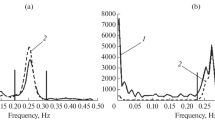Summary
Ten subjects (five males, five females) were studied in resting conditions. Ventilation (VT, f, TI, TE), heart rate (HR) and RR interval were recorded or measured. Each subject voluntarily breathed with spontaneous frequency at different ratios of his spontaneous tidal volume (V rT ). The results show that sinus arrhythmia increases with lung volume but without effect on mean heart rate. When VT is increased by two times its spontaneous value, the ventilatory drive (VT/TI) is raised in both sexes; the relative duration of inspiration (TI/Ttot) is modified (+20%) in females only. Thus with the cardiac effects of increasing lung volume being similar in both sexes, we conclude that sinus arrhythmia is not generated by sensory inputs from pulmonary structures, but that its origin is at the CNS level. Moreover, there may be a sex difference in the control of voluntary ventilation, a suggestion requiring further investigation.
Similar content being viewed by others
References
Angelone A, Coulter NA (1964) Respiratory sinus arrhythmia: a frequency dependent phenomenon. J Appl Physiol 19: 479–482
Anrep GV, Pascual W, Rossler R (1936) Respiratory variations of the heart rate. Proc Roy Soc (Lond) 119 B: 191–230
Daly M de B, Scott MJ (1958) The effects of stimulation of the carotid body chemoreceptors on heart rate in the dog. J Physiol (Lond) 144: 148–166
Eckberg DL, Orshan CR (1977) Respiratory and baroreceptor reflex interactions in man. J Clin Invest 59: 780–785
Gandevia SC, McCloskey DI, Potter EK (1978) Inhibition of baroreceptor and chemoreceptor reflexes on heart rate by afferents from the lung. J Physiol (Lond) 276: 369–381
Heymans C, Neil E (1958) Reflexogenic areas of the cardiovascular system. JA Churchill, London
Hirsch JA, Bishop B (1981) Respiratory sinus arrhythmia in humans: how breathing pattern modulates heart rate. Am J Physiol 241: H620-H629
Katona PG, Jih F (1975) Respiratory sinus arrhythmia: non invasive measure of parasympathetic cardiac control. J Appl Physiol 39: 801–805
Korner PI (1979) Circulatory homeostasis. Role of reflex interactions. Proc Aust Physiol Pharm Soc 10: 102–111
Levy MN, Degeest H, Zieske H (1966) Effects of respiratory center activity on the heart. Circ Res 18: 67–78
McCloskey DI (1979) Cardiorespiratory homeostasis. Proc Austr Physiol Pharm Soc 10: 40–43
McCrady JD, Vallbona C, Hoff HE (1966) Neural origin of the respiratory heart rate response. Am J Physiol 211: 323–328
Melcher A (1976) Respiratory sinus arrhythmia in man. A study in heart rate regulating mechanisms. Acta Physiol Scand [Suppl] 435: 1–31
Author information
Authors and Affiliations
Rights and permissions
About this article
Cite this article
Sébert, P. Heart rate and breathing pattern: Interactions and sex differences. Europ. J. Appl. Physiol. 50, 421–428 (1983). https://doi.org/10.1007/BF00423248
Accepted:
Issue Date:
DOI: https://doi.org/10.1007/BF00423248




